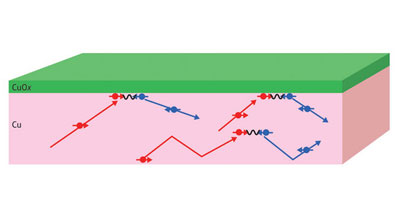| Posted: June 20, 2008 |
Cold copper stops the spin |
|
(Nanowerk News) In the future, many electronic systems could be replaced by spintronic devices, which communicate information via the intrinsic angular momentum, or spin, of electrons. Now researchers at the RIKEN Advanced Science Institute (formerly the Frontier Research System) in Wako and the University of Tokyo have completed an important study into the effects that temperature can have on spintronic devices (" Temperature Evolution of Spin Relaxation in a NiFe/Cu Lateral Spin Valve").
|
|
Spintronics relies on the effective transport of ‘spin-polarized’ currents, in which electrons all have the same spin. Spin-polarized currents flow well in magnetic materials, but when they enter non-magnetic materials the electrons begin to lose their spin polarization in a process called spin-flip scattering. The length scale over which the electrons remain polarized, called the spin diffusion length, is particularly important for fabricating devices.
|
 |
| Electron scatterings inside copper (Cu) sometimes flip the spin directions. On the other hand, scatterings at the boundary between Cu and copper oxide (CuOx) flip the spin every time. (Image: RIKEN)
|
|
Spin-flip scattering is known to occur in two different ways. At high temperatures, most of the scattering is caused by electrons interacting with ‘waves of heat’ called phonons. Otherwise scattering is caused by impurities, defects and boundaries in the material.
|
|
To investigate the effects of temperature on spin-flip scattering, the researchers fabricated a ‘lateral spin valve’ consisting of two magnetic electrodes that inject a spin-polarized current through a copper wire. The distance between electrodes was altered in order to observe the spin diffusion length of the copper at different temperatures.
|
|
The researchers found that the spin diffusion length of the copper increased as temperature was decreased. This was expected, because the phonon scattering decreases with temperature. However, there was an unexpected maximum at around 30 K (-243.15 °C), below which the spin diffusion length decreased again.
|
|
The researchers explained this effect by considering the wire surfaces, which are oxidized by the surrounding air and cause strong spin-flip scattering. At very low temperatures, the polarized electrons travel further on average, so they are more likely to collide with the wire surfaces. This explanation was verified by tests with different thicknesses of wire, showing that thinner wires with greater surface-area-to-volume ratio experience a greater level of scattering at low temperatures.
|
|
In very small devices, the scattering by oxidized copper surfaces could cause problems for real, room-temperature applications. RIKEN team-member Takashi Kimura suggests making use of aluminum, which reflects electrons rather than scattering them.
|
|
“We did not observe the spin signal maximum at low temperature in an aluminum lateral spin valve,” he explains. “Therefore, if we use an aluminum capping layer on top of the copper wire, it may prevent the present problem.”
|

